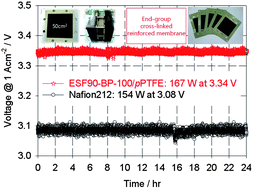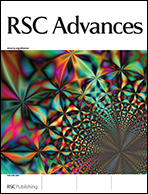End-group cross-linked large-size composite membranes via a lab-made continuous caster: enhanced oxidative stability and scale-up feasibility in a 50 cm2 single-cell and a 220 W class 5-cell PEFC stack†
Abstract
We present successful scaling-up feasibility of a large-size membrane-electrode assembly (MEA) using a newly developed thin composite polymer electrolyte membrane for fuel cell applications. The highly sulfonated end-group cross-linkable polymer electrolytes were synthesized and reinforced using a porous polytetrafluoroethylene (pPTFE) substrate of 15 μm thickness. Here, a lab-scale continuous caster was developed in order to fabricate thin composite membranes with a uniform thickness of 25 μm. The reinforced thin composite membranes exhibit an efficiently reduced water uptake and swelling ratio, and improved oxidative stability in Fenton's reagent compared to normal cast membranes. The optimized composite membrane was subsequently tested in a single-cell and a five-cell stack to demonstrate their feasibility for the scaled-up polymer electrolyte fuel cells (PEFCs). Eventually, the composite membrane successfully performed in the stack with low scale-up losses of about 2–3%. As a preliminary investigation, an in situ accelerated degradation test (ADT) is performed to evaluate the relative chemical durability of the composite MEA in a 50 cm2 single cell (at 100 °C with approximate relative humidity of 10%), and the degradation kinetic of the MEA (1.47 mV h−1) is comparable to Nafion®212 (1.45 mV h−1) during 24 h ADT.


 Please wait while we load your content...
Please wait while we load your content...